9/1/2018
Show Business
Chris Beytes, Jennifer Zurko, Ellen C. Wells, Jennifer Polanz & Allison Westbrook
The most talked about topics this year seemed to be labor and trucking. We’ve discussed these issues in many forms here on the pages of GrowerTalks and Green Profit, and unfortunately, the problem doesn’t seem to be getting better. To help address the labor shortage, equipment manufacturers were showcasing automated solutions—both those that could do the work or those that could make workers more efficient. As always, we’ll keep you updated on developments on these fronts.
Cannabis-related businesses were present, although it seemed that some had been weeded out (pun not intended), as the market fluctuates and matures. We noted that there were quite a few businesses promoting dehumidifiers for indoor cannabis production.
Another new element was the movement of the AmericanHort Networking Reception from outside the show to the show floor. It remains to be seen how attendees felt about this change, but we definitely saw some conversations over drinks near our booth. It seemed that the “tire-kickers” stayed home this year and those who came were ready to buy. Exhibitors we spoke to said that they were pleased with the customers that came through and had some great (and profitable) conversations.
And now, for the greatest hits from this year’s show.
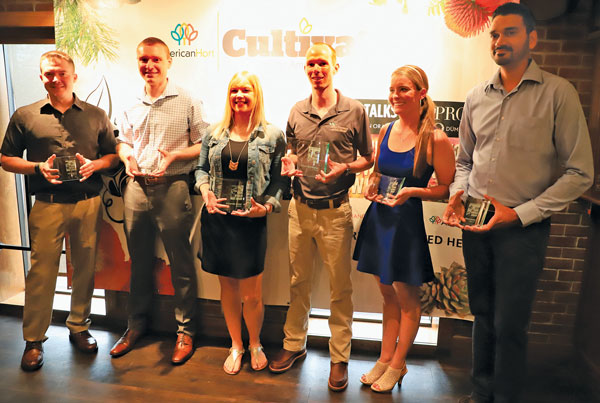
Plugging Into the Next Generation
Something that’s NOT missing from the Cultivate event are evening receptions. But the Unplugged event, hosted by AmericanHort’s Next Gen Committee, is one that celebrates the up-and-comers in our industry. It’s for this reason that, for the last eight years, we’ve chosen this venue as the perfect place to announce the winners of our annual GrowerTalks/Dümmen Orange Young Grower and Green Profit/Dümmen Orange Young Retailer Awards.
Speaking of which, the 2018 winners are: Evan Barrington (fourth from left), Head Grower and Pest Control & Irrigation Manager for May Nursery in Havana, Florida; and Amanda Bruce (third from left), general manager at Cedar Rim Nursery in Langley, British Columbia, Canada! The other four finalists are (from left): Matt Webster, Dambly’s Garden Center; Brian Stankevich, Homewood Nursery & Garden Center; Abby Bruce, Costa Farms; and Rajvir Prasher, DeVry Greenhouses.
Benchmarks for the Hort Industry
We get asked several times a year for a source of financial benchmarks for the greenhouse or nursery industries—comparisons for common measurements, such as sales volumes, payroll percentages, transportation costs, average shrink … stuff like that. Alas, those benchmarks simply didn’t exist.
Well, now they do, thanks to ag economist Dr. Charlie Hall of Texas A&M University, his partner Kellee O’Reilly of MonkeyBar Management and the alumni of the EAGL (Executive Academy for Growth & Leadership) program that Charlie leads.
At the request of EAGL grads, Charlie and Kellee have created “Your Market Metrics,” a dashboard of key financial metrics that allow subscribers to see how their own business compares to others. It’s similar to what you get when you belong to one of those garden center groups that share weekly and monthly sales data by department. It was launched in an invitation-only meeting on Saturday of Cultivate’18.
Charlie keeps all the data anonymous—as a subscriber, you get assigned a number and letter. You see your results compared to yourself over time, plus compared to other similar businesses and the entire membership. Your Market Metrics will start with eight key benchmarks: gross sales, net sales, net profit, total assets, net worth, payroll dollars, transportation cost and shrink dollars. Over the next several years, Charlie will add more benchmarks, such as cost of goods sold, interest expenses, taxes, depreciation, working capital requirements, production costs and more. Best of all, the dashboard metrics come with tips from Charlie himself for how your business is doing and what you need to be paying attention to and adjusting.
The initial subscription price is $2,750 and $1,500 per year after that. It may sound like a lot, but this gives you access to financial information that’s never existed before. Plus, they're offering a nine-month money-back guarantee if you’re not satisfied. All the EAGL graduates are on board, so you’ll be in very good company. Go to yourmarketmetrics.com to learn more.
Labor—A Pressing Issue
The “Perfect” Setup
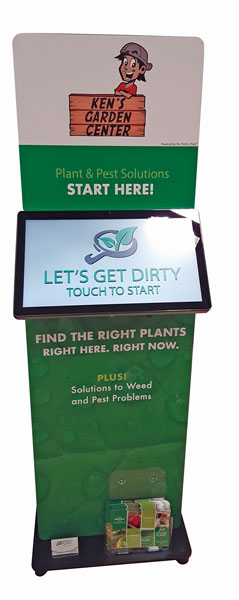 One of the biggest issues we’ve heard from almost all sectors of the industry—retail included—is labor and the sheer lack of it right now. What’s the solution? One solution is to create more silent sales opportunities, and as we were patrolling the show floor, we came across The Perfect Plant, a three-pronged technology-based approach designed to help employees and customers alike.
One of the biggest issues we’ve heard from almost all sectors of the industry—retail included—is labor and the sheer lack of it right now. What’s the solution? One solution is to create more silent sales opportunities, and as we were patrolling the show floor, we came across The Perfect Plant, a three-pronged technology-based approach designed to help employees and customers alike.
We’re not fond of the name because it implies it’s just a plant finder. It is a plant finder, but it’s also so much more than that. It’s a multifaceted product (the retailer can choose to participate in any of the three or all three): a kiosk in store, a component of the retailer’s website and a QR code program.
What’s great about it is there are already several different plant brands and varieties pre-loaded into the system, and the retailer can easily customize what appears for the customer, so they only see what the retailer sells. Seasonal items can be removed (they stay in the system, though) so they can only be seen when in season. A simple checked box removes them from view, then returns them when needed. The kiosk and website component offers a Plant Finder, Weed Finder and Bug Finder, as well as a Wish List. A disease segment is in future plans. For example, a retailer’s kiosk can help a customer identify a weed or bug, then suggest multiple solutions that the retailer carries.
The idea came to Ken Klopp II in 2007 when, as a turf grass management expert, he was overwhelmed with choice at a garden center and there was no one in sight to help him.
“I thought, ‘What if there was a way to quickly find what I needed?’” he notes, adding he tried to get the idea off the ground then but it didn’t work. He rejuvenated the idea in 2016 and is now in 16 states and in a seven-location retailer in New Zealand. The New Zealand operation is stretching the system to hook it into its POS system for even greater control and customization. Online sales could potentially be on the horizon, he says.
Retailers pay an affordable annual subscription cost, and we spoke with one retailer who has the system and was very complimentary of it. It’s been a great resource for new employees to help customers, as well. Find out more and see a demo at www.theperfectplant.com.
The Workforce of the Future
The concern about labor doesn’t just stop with today’s market. It’s a concern going forward, as fewer young people show an interest in the horticulture industry. You may have already heard about Seed Your Future, a nationwide industry organization founded in 2013 with more than 150 endorsing partners today. Why is it vital to our industry? According to statistics provided at a Cultivate talk this year, 39% of all “green-collar” jobs will go unfilled this year.
“We’re about broadening the pipeline of folks coming into this industry,” says Cole Mangum, vice president of production at Bell Nursery, who’s on the national leadership cabinet of Seed Your Future. The initiative focuses on a wide variety of careers within horticulture to show that it isn’t just about plants—there are careers related to science, HR, technology and business in our industry. Also, we may want to reconsider the word “horticulture.”
“Kids said to stop using the word horticulture—to use a different title,” says Susan Yoder, executive director of Seed Your Future, during the talk. She highlighted research conducted among the younger generation. “They said horticulture is weird … Plantology is cool.”
There are lots of activities going on under the Seed Your Future umbrella and a few have ways for everyone to get involved. The organization is partnering with Scholastic, which has a huge reach into U.S. classrooms, to include an online learning module for educators and outside classroom clubs like 4-H, Boys and Girls Clubs, scouts and more. There are a couple of websites to visit, including www.WeAreBloom.org, which is a site that includes sections for kids, parents and partners (that’s you!).
In the partner section, you can find a toolkit to help you spread the word about our great industry. This site has videos highlighting people in our industry who have cool jobs that are designed to appeal to kids. There are 18 uploaded, with plans for 20 more. Also, if you go to www.SeedYourFuture.org you can click on the “Get Involved” tab to find out ways you can help. The organization also is conducting research, like a follow-up to a 2014 study to look at college and university enrollment in hort fields to determine trends.
So what can you do personally? Engage, Cole says. Host local school kids at your greenhouse or garden center (or whatever facility you have), and teach them about local plants. Open their eyes to the careers available in our industry. Make a video about your job and share it on social media with the hashtag #ILoveMyPlantJob.
New Products
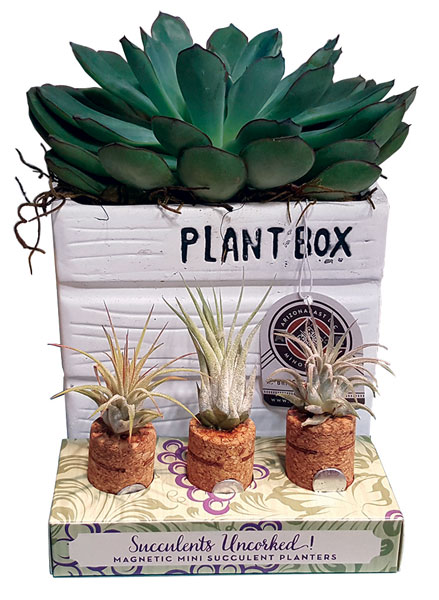 Retail Eye Candy
Retail Eye Candy
The Arizona East booth immediately caught our eye because of its on-trend products, from small houseplant décor to creative airplant designs and succulent planters. Right now, houseplants, succulents and airplants are Instagram eye-candy, and these planters help keep green products in the spotlight.
The company, according to Marketing Specialist Casey Prokop, has two main lines that were introduced at Cultivate: Farmhouse (self-explanatory) and Wit ’n Whimsy, which has colors and designs inspired by the mermaid and unicorn craze. Many of the designs are neutral with pops of color that have been inspired from lifestyle bloggers and the home décor industry.
Casey says the company is working on a Valentine’s Day seasonal collection, as they’re seeing greater demand for indoor seasonal items. You can find more information at www.arizonaeast.com.
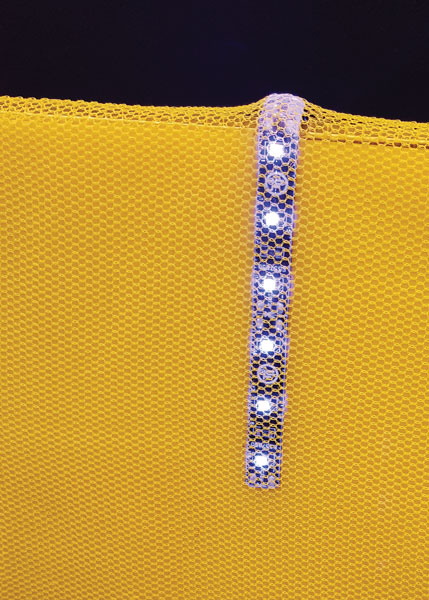 Like a Moth to the Flame
Like a Moth to the Flame
Just like the winged insects it’s designed to attract, the LED light shining through this yellow insecticidal screen drew us into the AgBio Inc. booth to investigate further. The patent on the technology—named Dead-Inn LED Light Traps—is pending and it’s designed to attract pests like aphids, fungus gnats, whiteflies and thrips. According to Sales Representative Parker Meneley, the LED helps to attract the pests at night to the yellow screen, branded D-Terrence, that’s pre-treated with a long-lasting insecticide. The screen kills pests on contact. As of press time the company was waiting for EPA approval on the product.
The D-Terrence system is recommended to be used around cooling systems, or in windows and ventilation openings, as well as to separate bays. That product is inspired from pre-treated mesh used as mosquito control in other countries, Parker notes. Find out more at www.agbio-inc.com.
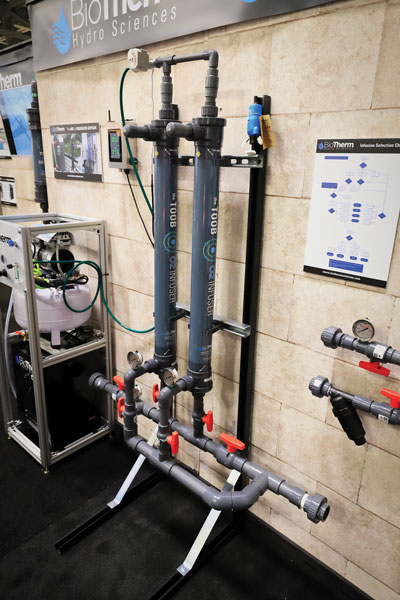 BioTherm’s Toob O2 Infuser
BioTherm’s Toob O2 Infuser
A technology we’re still learning about is dissolved oxygen in irrigation water and its effect on plant growth. This came up when Jim Rearden of BioTherm showed us his newest tool, called the “Toob” O2 infuser. It’s an alternative to oxygen injection or ozonation systems for adding dissolved O2 to irrigation water. Coming from the biomedical world of heart-lung machines, the Toob contains upwards of a mile of ultra-fine fibers that somehow put dissolved oxygen into the water as it passes through. Normal “healthy” water contains 8 ppm of dissolved O2; the Toob can increase that to 30 ppm, “supersaturating” your irrigation water, which can boost root and plant growth, and increase overall plant quality. It has some sanitation effects, as well, Jim says.
www.biothermsolutions.com
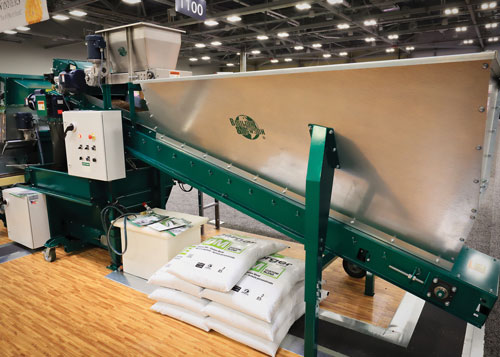 B&L Low-Profile Incorporator
B&L Low-Profile Incorporator
If you’re a small- or medium-sized grower looking to begin your own soil mixing, Bouldin & Lawson’s Low Profile Incorporator might be just the ticket. Available in 2- or 4-yard capacities, it provides the smaller grower with the same blending capabilities of a big system, but in a smaller footprint. It can feed any tray or pot filler, and its low height makes it easy to keep loaded with raw materials. bouldinlawson.com
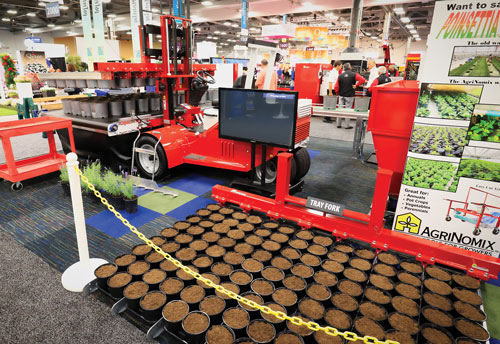
Fork it Over
Forks for moving plants aren’t new, but they’re extremely effective and efficient, and come in all shapes, sizes and price points. Which is why AgriNomix dedicated a corner of their always-large display to a variety of fork technologies. The Pot Fork (left) uses a special trike-style lift truck to move a large number of pots from buffer belt to floor and back to buffer belt. It can even space pots automatically, through its hydrostatic transmission. The Tray Fork attachment (right) offers the same mobility, except for shuttle trays or flats. And even the small grower can make use of manual pot forks, which let one worker move six or eight or more pots at a time. agrinomix.com
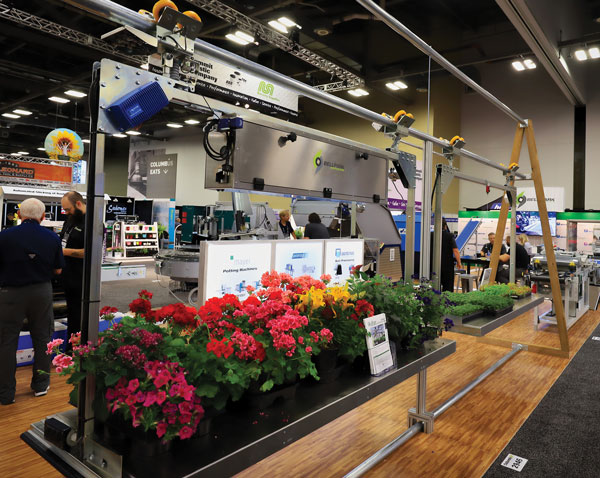 Catch the Skytrain
Catch the Skytrain
Automation distributor Bellpark (formerly Visser NA), showed the first monorail internal transport system we’d seen in a while … in fact, we thought the technology was rather old-fashioned and out-of-date until we saw this high-tech spin on it. The Skytrain is battery powered and runs around your greenhouse linked in pairs—one powered and one hitched on for the ride. Moveable magnets tell the trains to stop at “stations” around your facility for loading and unloading. The two 12-volt auto batteries last up to 12 hours and the motors are stout enough to climb a 10-degree slope. Made in the Netherlands, a two-car train goes for about $20,000, plus track. www.bellparkhorticulture.com
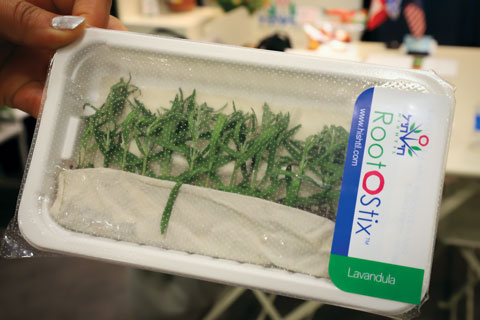 Hishtil RootOStix
Hishtil RootOStix
As we see more URC-sticking automation come along, we’ll see more URCs being packaged specifically for them. As is the case with Hishtil’s RootOStix, packed specifically for the AutoStix machine. These are rooted cuttings, shipped in AutoStix strips, and packed in a manner that will keep the roots protected and moist. They’ve been tested in Israel and at key customer sites. The idea, they say, is to allow AutoStix customers to plant directly into the finished container, rather than into a liner tray for rooting. Eventually, the technology could eliminate an entire step in the production process: the rooting station. www.hishtil.com
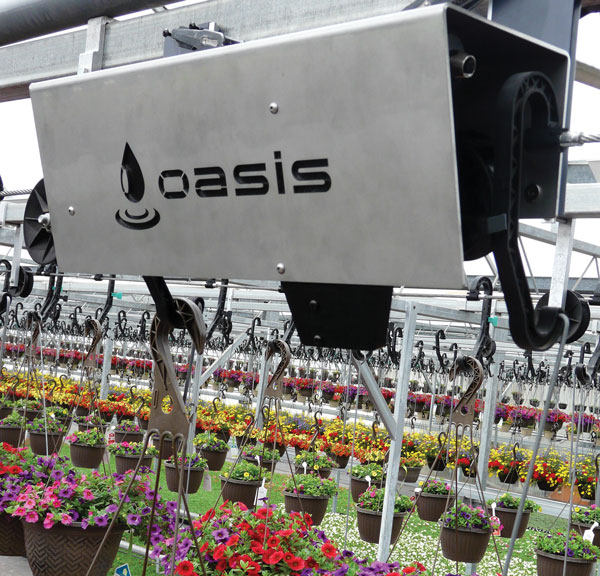 Watering Baskets by Weight
Watering Baskets by Weight
Jordan and Jared Dekker were featured on the cover of GrowerTalks in 2015. Then 30 years old, the identical twins impressed us with their enthusiasm and business savvy.
Now, Jared and Jordan are adding "technology suppliers" to their list of projects. They’ve developed and launched (in partnership with controls engineer and master electrician Len Logsdon), an irrigation controller for overhead basket conveyors that waters based on the weight of each pot rather than simply hitting every basket with an equally timed blast. They call the product OASIS and their company for supplying them Control Dekk.
The OASIS module attaches to any existing or new hanging basket conveyer, such as ECHO or Boomerang, converting it to a weight-based watering system. The grower establishes the ideal weight of a watered basket, programs it into the system and the computer does the rest. It also stores your irrigation data for future analysis. You can control plant growth without PGRs, water heavier when you’re about to ship and manage your basket watering from a phone or tablet. www.controldekk.com

Dramm
Dramm hoses are tough as nails and last forever—not to mention they come in some really cool colors. But if there’s one downside to their Colorstorm line, it would be that Dramm hoses can be a bit bulky for the average home gardener. The brilliant minds at Dramm have addressed that issue with the introduction of the new 1/2-in., 25-ft. long Colorstorm Premium Rubber Hose. It’s made of the same tough EPDM rubber, has the same crush-proof, nickel-plated brass couplings, and has the same color options—it’s just a smaller diameter, making it lighter, easier to handle in small spaces and easier to store.
SynRG Barberries
Barberries were once a must-have colorful landscape shrub, but have been banned in many states due to their fruit set and invasive habit. Now homeowners and designers can start adding them back into their landscapes and designs. After 15 years of research and trialing at the University of Connecticut, WorryFree Crimson Cutie (pictured) and Lemon Glow are the first sterile barberries introduced by SynRG Growers. Now there’s no longer a need to search for a tough-as-nails, versatile and deer-resistant alternative for barberries—WorryFree brings the barberry back.
More Earth-Friendly Peat
Wood fiber amendments seem to be a popular product lately, so it’s appropriate that Lambert has rolled out a new line of natural wood fiber substrate called EcoPeat. The reason why it’s “eco” is because the wood comes from the trees that have been buried in their peat bogs for centuries. National Account Manager Otto Kaufmann explained that the bogs are full of ancient fir and spruce trees that have fallen over the years. In the past, that debris would have been set aside, or even used to build roads into the bogs. Now Lambert has figured out a way to process them to use in growing media. Unlike bark, the wood fibers in EcoPeat last longer and offer better air space and porosity for drainage. Also, as the trees are being removed from the bogs, only a small amount of peat actually comes with it, so Lambert is able to maintain their peat bogs longer, making it a more sustainable product. There are quite a few formulations with various percentages of wood fiber and peat, depending on your crop and its needs. Otto says it’s less expensive than perlite mixes. One note: Due to the wood fiber size, EcoPeat isn’t ideal for plug trays. www.lambertpeatmoss.com

Speedgrow Green Rockwool
From distributor BFG Supply comes a new product category for them: rockwool for hydroponic growers. Called Speedgrow Green, it’s less dense than competing rockwool products, they say, for better air circulation, drydown and root penetration. It features an organic, glucose-based binder. Speedgrow Green comes in various popular sizes used in hydroponic production. www.bfgsupply.com
Exclusives from Emerald Coast Growers
Perennial and ornamental grass supplier Emerald Coast Growers was displaying many of their wares that are only available from them.
First, is a new collection of pennisetum that’s infertile. John Friel, marketing manager for Emerald Coast and Green Profit columnist, said that the main complaint landscapers have with these grasses is that they re-seed and spread. Not so with these. Plus, there are more touchable flower heads that last longer than others on the market. There are five total pennisetum, with Praline (pictured) the smallest one in the collection.
Goldilocks joins the Li’l Bang series (along with Darling Clementine, not pictured) of coreopsis with tiny delicate flowers on a dwarf habit.
A new series of Rudbeckia hirta called Smileyz, is actually vegetatively propagated from a breeder in Holland for a more uniform habit and sturdier stems. Since this species isn’t hardy, it makes a great plant for large containers and annual beds. All seven have dark, chocolate-colored centers. Pictured: Glowing. www.ecgrowers.com
Cannas from J. Berry
J. Berry Nursery gave Cultivate attendees a first look at their new line of cannas called Cabana. Cabanas are naturally compact and are from tissue culture, which means less disease issues popping up and allows for more consistent growth. There are eight colors so far, with Vanilla being the most interesting because it’s difficult to breed white into a canna. With breeding from South Africa, Cabana callas are tolerant of heat and temperature extremes. The Cabanas themselves are more local, coming from J. Berry’s new young plant division, which they just started to help get their genetics out to their customers a little more quickly and efficiently.
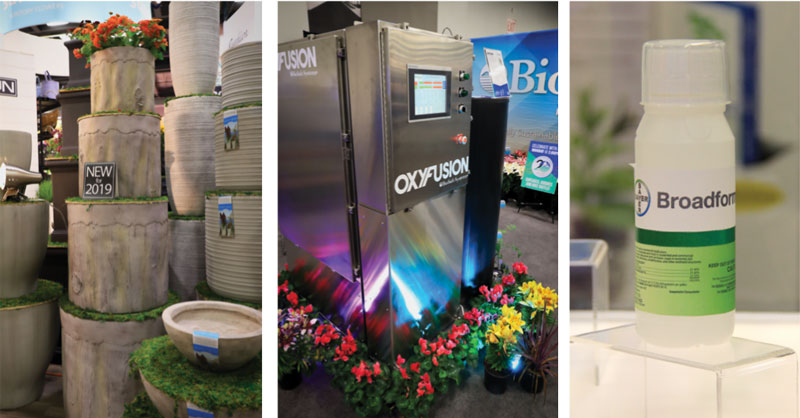
Reclaiming the Reclaimed Look
Braun Horticulture has added several new container designs for 2019, including these Tree Trunk planters, sold in sets of four; and these metal Honeycombs in round, square and oval, part of their Urban Collection. As an aside, we were told by Braun’s Amadeu Pacheco that they can once again supply topiary forms (they’d suffered a shortage of supply, due to production problems). www.braungroup.com/garden-products
Adding PAA Yourself
What’s PAA? If you have to ask, you probably aren’t ready for BioSafe System’s OxyFusion.
PAA is peroxyacetic acid, the powerful anti-microbial and water disinfectant. It and hydrogen dioxide are the active ingredients in BioSafe’s ZeroTol algicide/bactericide/fungicide. The OxyFusion device produces PAA onsite, injecting it directly into your irrigation water in very precise concentrations. This gives you on-demand water treatment for disease control and prevention of biofilm in your irrigation lines, among other benefits. Who is it for? “The grower who understands PAA and its benefits,” they say.
Best of all, you don’t have to buy the OxyFusion machine: you lease it with the cost based on how many gallons of water you treat. BioSafe provides free maintenance and service. biosafesystems.com
Bayer’s New Fungicide
Now that Bayer is fully into the ornamentals market, they’ve been busy working on new formulations you can use in your greenhouse. Broadform is the company’s newest fungicide which, as the name implies, controls more than 50 diseases, including botrytis, anthracnose and powdery mildew. Bayer has been conducting trials for a few years with many of the industry’s well-known disease experts and researchers, including Ann Chase, Janna Beckerman and Margery Daughtrey.
With the active ingredient fluopyram and formulated as a soluble concentrate, Broadform works systemically as a foliar spray, with a long residual in the leaf and good stem and bud penetration. Broadform has a 12-hour REI and a caution signal word. You can use it on all ornamental plants, including non-fruit-bearing trees, in the greenhouse, nursery, interiorscape, on landscape ornamentals and in other enclosed structures. It will be available September 1, with California registration coming. www.backedbybayer.com
 Bates Sons & Daughters
Bates Sons & Daughters
Tropical combos are hot summertime items for garden centers. Bates Sons & Daughters can set you up with some tropical flair with two new caladium varieties. Sparkler is a “love it or hate it” coloration: long leaves have a mostly green center area surrounded by pink and white splotches and streaks (some leaves are solid green). Flamingo has a bright-pink and green edged heart-shaped leaf.
New Inputs from RainSoil
RainSoil’s tagline is “Retain Your Rain,” so their main focus for their soil and soil amendments is to provide products that give your crops the best rootzone environment with better water retention. The first of the two products they showed us was RainSoil Engineered Super Soil, a retail-packaged soilless media made from 100% coconut coir sourced from India that you can use for virtually anything—from hanging baskets to lawns to hydroponics. It includes a starter charge of fertilizer, a surfactant and their patented water-holding polymer.
Their second new product is InvigoRoot, which, as the name implies, helps with developing a healthy root system on seedlings. A hormone-free, 5-5-0 liquid fertilizer chock full of polypeptides (chains of amino acids), InvigoRoot gets applied when you first see roots and then again seven to 10 days after the first treatment. It can be used on ornamentals and edibles. www.rainsoil.com GT